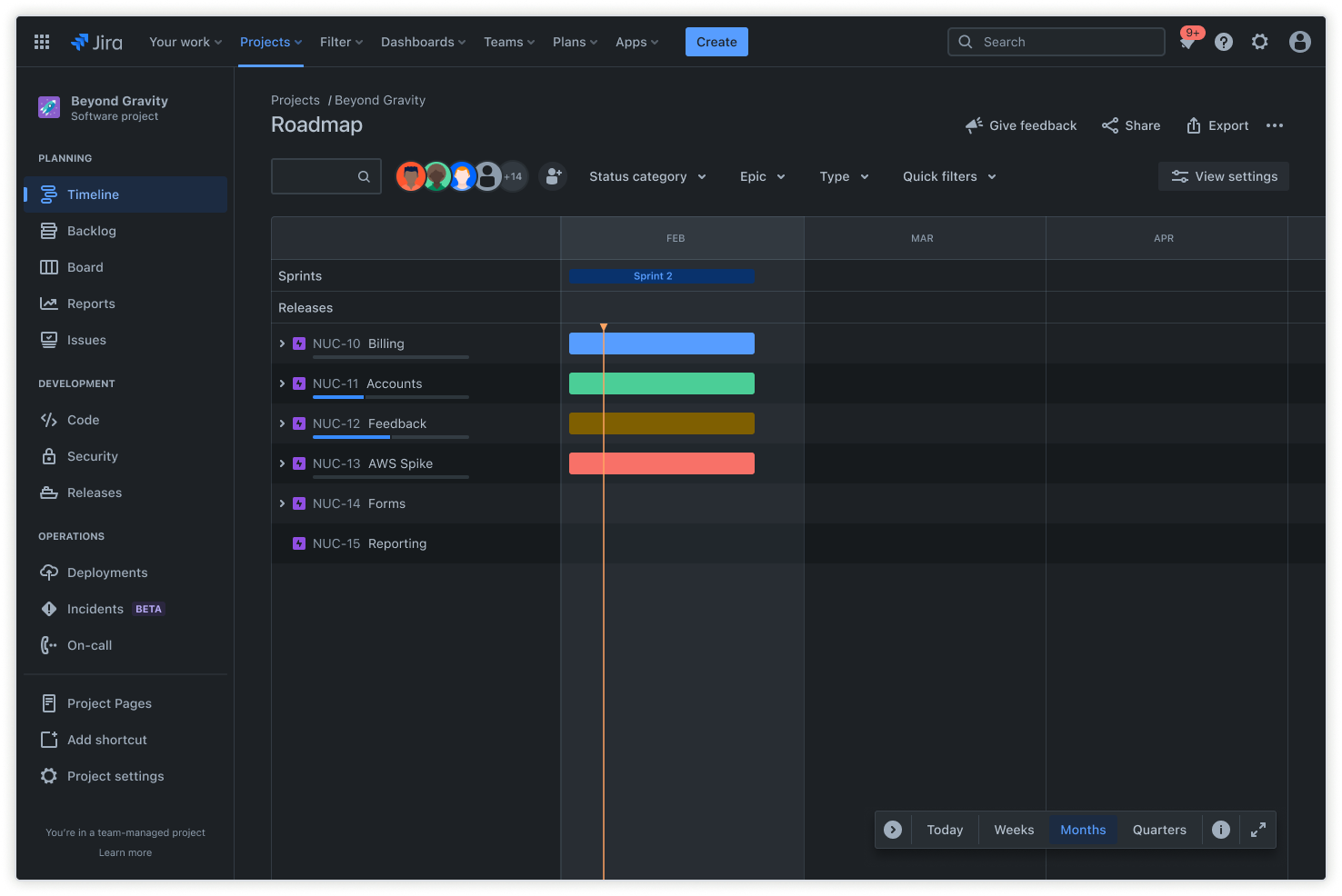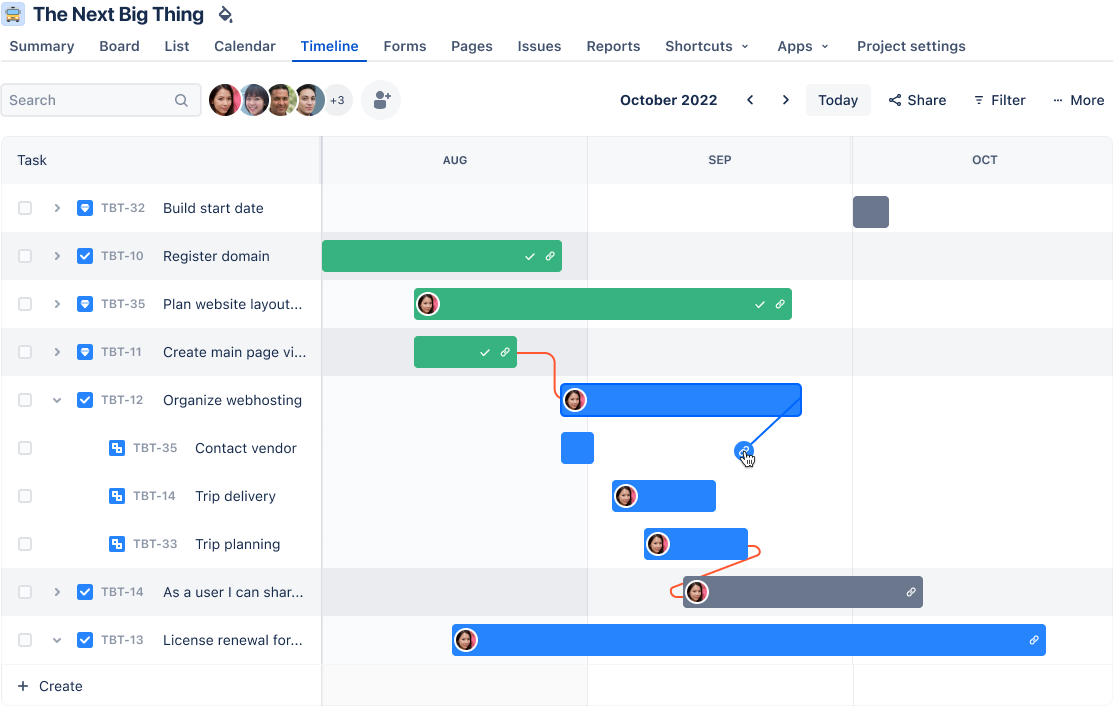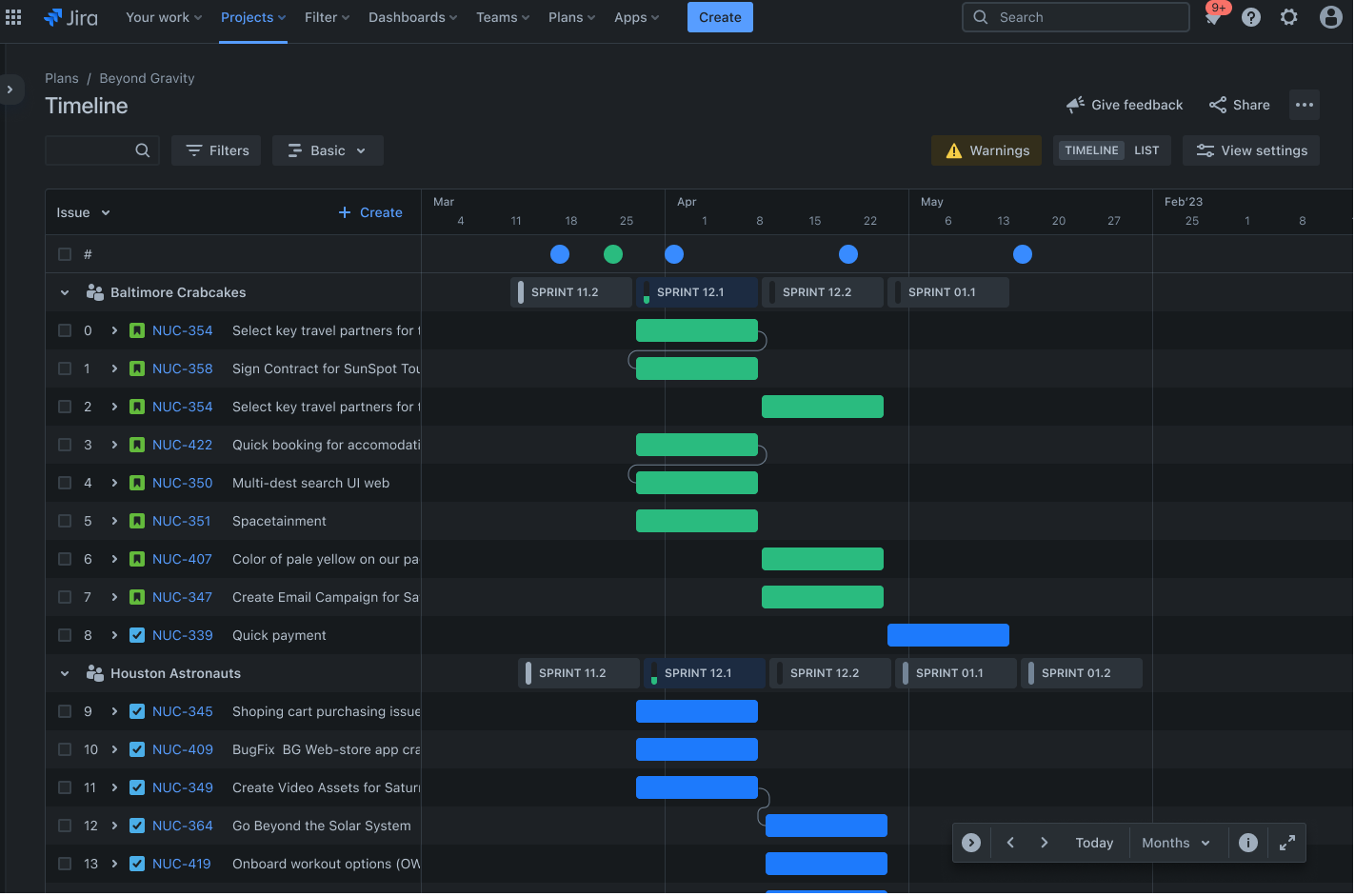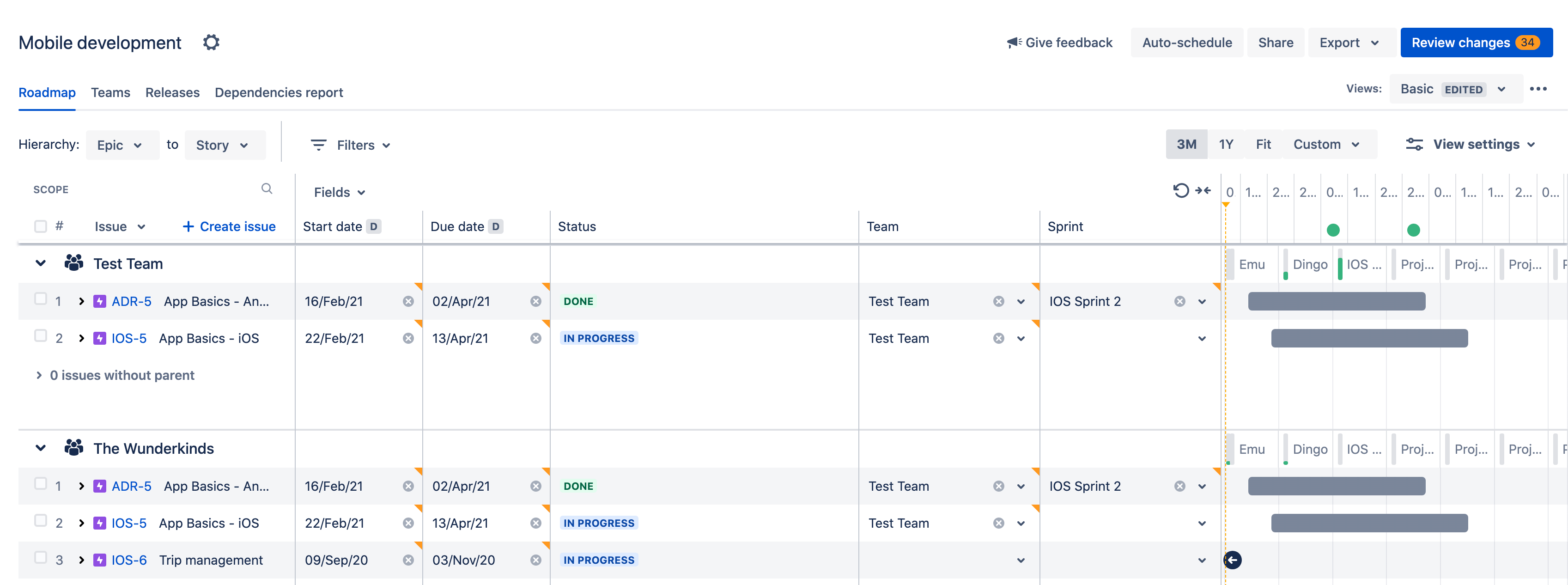Summary: A Gantt chart is a visual timeline for tracking tasks and milestones throughout a project's lifecycle. It offers a high-level overview of project schedules, making it easier to manage complex plans involving multiple teams and shifting deadlines. By providing clear visibility, Gantt charts empower project managers and teams to stay organized and focused on achieving their goals together.
Whether you're managing sprints or long-term projects, this comprehensive guide explores what Gantt charts are, their practical applications, and the many benefits they offer.
Czym jest wykres Gantta?
A Gantt chart is an agile project management tool used to plan and track the progress of various tasks and activities within a project. Serving as a visual timeline, it displays the list of tasks, their start and end dates, milestones, dependencies between tasks, and assignees.
As a valuable roadmap, a Gantt chart guides teams and organizations in effectively planning and coordinating their work items. By illustrating task interconnections, it fosters seamless collaboration and alignment among project stakeholders, ensuring everyone is on the same page and working towards the same goal.
Zalety korzystania z wykresów Gantta
Wykresy Gantta mają dwie główne zalety.
Simplifies complex planning
Gantt charts make it easier to create complex plans, particularly those involving multiple teams and shifting deadlines. They also help teams schedule tasks around deadlines and allocate resources efficiently.
Enhances task scheduling and resource allocation
Project planners rely on Gantt charts for a high-level overview, showing key details like task start and end dates, milestones, and dependencies. Modern Gantt chart programs like Jira Timelines and Jira's Advanced Planning synthesize information and illustrate how choices impact deadlines.
Gantt chart components
Gantt charts typically include two sections; the left side outlines a list of tasks, while the right side shows a project timeline with schedule bars that visualize work. Let's take a closer look at the primary components to look for in a Gantt chart.
Lista zadań

A task list is a comprehensive list of all tasks required to complete the project. In Jira, tasks can be created and managed using the issue tracker, which allows you to assign tasks to team members, set priorities, and track progress. This ensures that every team member knows their responsibilities and deadlines, promoting accountability and efficiency. For example, a software development team uses the task list to assign coding, testing, and deployment tasks to different developers, ensuring a smooth workflow.
Oś czasu

The timeline is a visual representation of the project schedule, showing start and end dates at the top of the chart. Jira's Timeline feature provides a clear view of your project schedule, helping you visualize the sequence of tasks and their durations. Timelines help identify potential bottlenecks and allow for proactive adjustments to keep the project on track. For example, a marketing team uses the timeline to plan a product launch, ensuring all promotional activities are aligned and executed on time.
Zależności

Links between tasks dictate the order of operations and show how tasks are related. Jira's Advanced Roadmaps allows you to set dependencies between tasks, ensuring that tasks are completed in the correct order and automatically adjusting schedules when changes occur. This prevents delays by ensuring that prerequisite tasks are completed before dependent tasks begin. In a construction project, for example, dependencies ensure that foundation work is completed before building the structure.
Kamienie milowe

Project milestones on Gantt charts are markers on the project timeline indicating major progress or completion of project phases. In Jira, you can mark key milestones using milestone markers, which help keep your team focused on critical deadlines and achievements. Milestones provide motivation and a sense of accomplishment, helping teams stay focused on long-term goals. A product development team sets a milestone for completing the prototype phase, signaling readiness for user testing.
Do czego służą wykresy Gantta?
Kierownicy projektów korzystają z wykresów Gantta z trzech głównych powodów.
Tworzenie kompleksowego projektu i zarządzanie nim
Wykresy Gantta wizualizują elementy składowe projektu i organizują go w mniejsze zadania, którymi można łatwiej zarządzać. Te zadania znajdują się na osi czasu wykresu Gantta wraz z zależnościami między zadaniami, osobami do nich przypisanymi i kamieniami milowymi.
Określanie logistyki i zależności między zadaniami
Wykresy Gantta pozwalają monitorować logistykę projektu. Zależności między zadaniami pozwalają się upewnić, że nowe zadanie zostanie rozpoczęte dopiero po zakończeniu innego zadania. Opóźnione zadania powodują automatyczne zmiany harmonogramu. Może to być szczególnie przydatne podczas planowania w środowisku wielu zespołów.
Monitorowanie postępów projektu
Gdy zespoły rejestrują czas poświęcany na zgłoszenia w planie, możesz monitorować kondycję tych projektów i w razie potrzeby wprowadzać zmiany. Wykres Gantta może zawierać daty wydania, kamienie milowe lub inne ważne dane służące do śledzenia postępów projektu.
Jak utworzyć wykres Gantta
Mając na uwadze zalety wykresów Gantta, zbadajmy, jak przełożyć plany projektów na przejrzysty i możliwy do zrealizowania wykres. Omówimy podstawowe kroki — od zdefiniowania zakresu projektu po śledzenie postępów — aby się upewnić, że wykres Gantta stanie się cennym narzędziem do udanej realizacji projektu.
Step 1: Define the project scope
Pierwszym krokiem w tworzeniu wykresu Gantta jest zdefiniowanie zakresu projektu. Zacznij od określenia jego głównych celów. Jasne cele będą kierować projektem i zapewnią, że wszystkie zadania będą z nimi zgodne w całym cyklu życia projektu.
Gdy już osiągniesz cele, nakreśl kluczowe rezultaty. To namacalne wyniki, które musisz osiągnąć w trakcie całego projektu.
Step 2: List all tasks and subtasks
Następnie wymień wszystkie zadania niezbędne do osiągnięcia każdego rezultatu. Te duże podziel na mniejsze zadania podrzędne, aby wyraźnie pokazać zespołowi, co musi zrobić. Zidentyfikuj każde zadanie, odpowiedzialnego za nie członka zespołu oraz wymagane zasoby.
Step 3: Estimate task duration
Określ, ile czasu zajmie wykonanie każdego zadania. Podejdź do sprawy realistycznie i rozważ wszelkie potencjalne opóźnienia. Pozostaw w harmonogramie bufor, aby przygotować się na nieoczekiwane opóźnienia i zapewnić terminowe ukończenie projektu.
Step 4: Determine task dependencies
Zidentyfikuj kolejność zadań. Niektóre z nich mogą się rozpocząć dopiero po ukończeniu innych. Do definiowania relacji między zadaniami używaj typów zależności, takich jak „od zakończenia do rozpoczęcia” lub „od rozpoczęcia do rozpoczęcia”.
Step 5: Choose a Gantt chart tool
Wybierając narzędzie do tworzenia wykresów Gantta, oceń kilka czynników, aby się upewnić, że spełni potrzeby Twojego projektu.
Jira is an excellent option for creating Gantt charts, particularly for software development teams. Tools such as Timelines and Plans help you create advanced roadmaps. These features support detailed task management, dependency tracking, and resource allocation. You can even use a Gantt chart template to streamline the process.
Step 6: Input data
Po uzyskaniu wszystkich informacji wprowadź dane do wybranego narzędzia. Wprowadź na wykresie Gantta wszystkie zadania i odpowiadające im czasy trwania. Ustaw zależności między zadaniami, aby ich kolejność była przejrzysta. Uwzględnij kluczowe kamienie milowe, aby podkreślić istotne punkty na osi czasu projektu.
Najlepsze praktyki dotyczące tworzenia efektywnych schematów blokowych procesów
Tworzenie skutecznego wykresu Gantta wymaga czegoś więcej niż tylko wprowadzania danych. Poniżej znajduje się kilka najlepszych praktyk, które warto stosować.
- Prostota i przejrzystość. Unikaj zaśmiecania wykresu Gantta zbyt dużą ilością informacji. Oszczędnie używaj kolorów i etykiet oraz uwzględnij tylko najważniejsze zadania i zależności.
- Używaj kolorów. Pomagają one lepiej zwizualizować różne typy lub etapy zadań. Poprawiają też czytelność widoku osi czasu i ułatwiają śledzenie postępów.
- Jasna komunikacja. Upewnij się, że wszyscy członkowie zespołu rozumieją wykres Gantta, używając przejrzystych opisów zadań, znaczników kamieni milowych i typów zależności. Pomoże to uniknąć nieporozumień i zapobiegnie błędom.
- Udostępnij wykres członkom zespołu i interesariuszom. Udostępnij swój wykres Gantta wszystkim zainteresowanym osobom, aby cały zespół był z nim na bieżąco. Informuj wszystkich o wszelkich zmianach w wykresie Gantta.
- Regularnie aktualizuj wykres. Wykres Gantta powinien być żywym dokumentem aktualizowanym regularnie w całym cyklu realizacji projektu. Wprowadzaj odpowiednie zmiany, aby zachować dokładność osi czasu przy każdym wykonanym lub opóźnionym zadaniu.
-
Uwzględniaj opinie i uwagi. Regularnie szukaj informacji zwrotnych od swojego zespołu i uwzględniaj je w wykresie Gantta, aby poprawić jego dokładność i skuteczność.
How different stakeholders utilize Gantt charts
Gantt charts are versatile tools that cater to the diverse needs of various stakeholders within a project team. Here's how different roles utilize Gantt charts, the components they focus on, the questions they aim to answer, and the common challenges they face:
Menedżerowie projektów
Project managers use Gantt charts to oversee the entire project timeline, manage resources, and ensure deadlines are met.
Key questions: "Are we on track to meet our deadlines?" "What resources are needed at each phase?" "How do task dependencies affect the project timeline?"
Common challenges: As a project manager, juggling complex dependencies and resource allocation can be tricky. Jira's Advanced Roadmaps feature helps by automatically adjusting schedules when dependencies change and providing a clear view of resource allocation.
Członkowie zespołu
Team members focus on their specific tasks and dependencies to understand their role in the larger project. They interact most with the task list and timeline components to track their responsibilities and deadlines.
Key questions: "What tasks am I responsible for?" "What are the deadlines for my tasks?" "How do my tasks fit into the overall project?"
Common challenges: Managing tasks and tracking changes and dependencies can be constantly shifting. Jira's real-time collaboration and issue tracker features ensure team members are always updated on task changes or dependencies shifts.
Interesariusze
Stakeholders view high-level progress and milestones to stay informed about the project's status. They focus on milestones and visual aids to grasp the project's progress quickly.
Key questions: "What is the current status of the project?" "Have we reached key milestones?" "Are there any major risks or delays?"
Common challenges: When trying to understand complex project details, stakeholders can feel easily overwhelmed by information. Jira's customizable views and milestone markers provide stakeholders with a clear, high-level overview of the project, ensuring they are informed without being overwhelmed.
By leveraging Jira's robust features, each stakeholder can effectively use Gantt charts to meet their specific needs, ensuring a cohesive and well-managed project.
Key features of Gantt chart software
Gantt chart software, like Jira, offers advanced features to enhance project management efficiency and effectiveness. Here's why these features are essential:
Automatic scheduling
This feature automatically adjusts timelines when task dependencies change, ensuring your project plan remains accurate and up-to-date. It saves time and reduces the risk of human error, allowing project managers to focus on strategic planning rather than manual updates.
Zarządzanie zasobami
Efficient resource allocation is crucial for project success. Effective resource management features help distribute tasks and resources across teams, optimizing workload and preventing burnout. This ensures that all team members are utilized effectively, contributing to a balanced and productive work environment.
Współpraca w czasie rzeczywistym
With real-time collaboration, team members can update progress and communicate changes instantly. This feature fosters transparency and keeps everyone aligned, reducing miscommunication and enhancing team cohesion. It is particularly beneficial for remote teams or projects with tight deadlines.
Customizable views
Different projects require different perspectives. Jira offers customizable views, such as daily, weekly, or monthly timelines, to suit various planning needs. This flexibility allows project managers to tailor their Gantt charts to specific project requirements, improving clarity and focus.
Integrations and compatibility
Gantt chart tools are most effective when they integrate seamlessly with other project management software and platforms. Jira excels in this area by offering robust integrations with tools like Trello and BigPicture. These integrations enable smooth project management across different systems, enhancing collaboration and efficiency.
By incorporating these features and integrations, Jira is a comprehensive solution for modern project management needs.
Jak korzystać z wykresów Gantta w Jirze
Jira ma dwie funkcje ustalania harmonogramów. Każda z nich ma nieco inne zastosowanie. Osie czasu Jira śledzą prace przypisane do jednego zespołu, a Plany nadają się do planowania większych projektów międzyfirmowych.
Wykresy dotyczące konkretnego projektu: Osie czasu Jira
Powyższy zrzut ekranu strony Osie czasu pokazuje wykres Gantta konkretnego projektu, który jest powszechnie używany na poziomie zespołu lub w ramach jednego działu. Wykres przedstawia sposób, w jaki zespół śledzi postępy w kierunku realizacji celów, a zwijana struktura podziału pracy pozwala kierownikom projektów uzyskać ogólny wgląd w kluczowe historyjki w projekcie. Jira oferuje darmowy szablon zarządzania projektem, w którym znajdziesz wykresy Gantta.

Wykres organizacyjny wysokiego poziomu: Plany
Plany Jira umożliwiają łatwe i szybkie planowanie, dzięki czemu zespoły mogą lepiej zarządzać zależnościami i śledzić postępy z szerszej perspektywy w czasie rzeczywistym. Te harmonogramy na poziomie projektu lub zespołu przydają się do planowania dużych jednostek pracy w ramach jednego zespołu.
Do planowania i śledzenia pracy oraz zarządzania nią w wielu zespołach, a nawet całej organizacji, warto stosować Plany.

Programy przeznaczone do obsługi przepływów pracy obejmujących wiele zespołów oferują bardziej zaawansowane narzędzia, takie jak zarządzanie potencjałem wykonawczym i funkcje automatycznego planowania, które ułatwiają tworzenie bardziej złożonych planów. Oferują także różne ustawienia widoku, które umożliwiają dostosowanie wykresu Gantta, aby wyróżnić pewien aspekt planu.
Elevate your project management with Jira's Gantt charts
Transform your project management approach with the power of Gantt charts in Jira. These visual timelines are not just about tracking tasks—they're about achieving your project goals precisely and clearly. By leveraging Jira's robust features, you can create Gantt charts that are efficient and pivotal in steering your projects toward success.
Jira seamlessly integrates with various Gantt chart tools, providing a holistic project tracking and management solution. This integration ensures that your project timelines are always up-to-date, allowing real-time adjustments and insights.
Harness the full potential of Jira's capabilities to manage your Gantt charts effectively. With real-time updates, customizable dashboards, and advanced reporting, Jira empowers you to keep your projects on track and your team aligned.
Are you ready to revolutionize your project management strategy?
Powiązane zasoby
- Zasoby do zarządzania projektami
- Zasoby do planowania projektów
- Zasoby do wprowadzania produktów na rynek
- Zarządzanie projektami — strategie wejścia na rynek
- Zarządzanie zasobami — zasoby
- Śledzenie zadań — zasoby
- Zarządzanie projektami marketingowymi — zasoby
- Zarządzanie programami — zasoby
- Zasoby dla kierowników projektów
- Zarządzanie projektami oprogramowania
